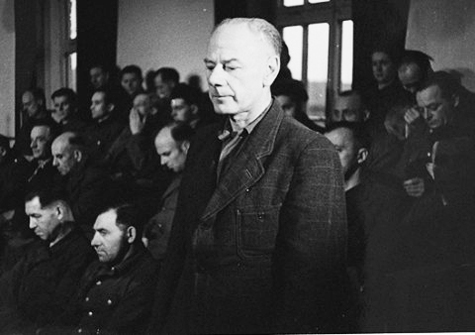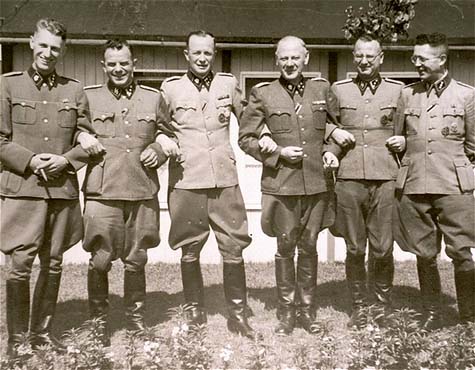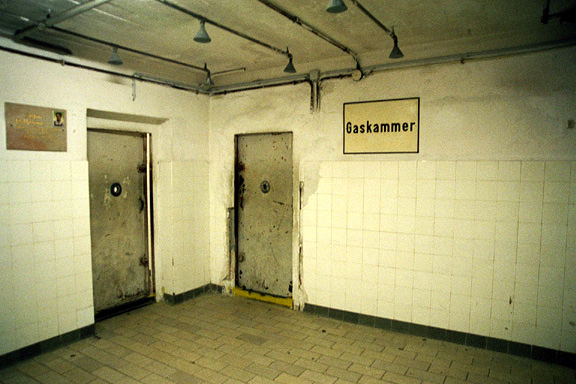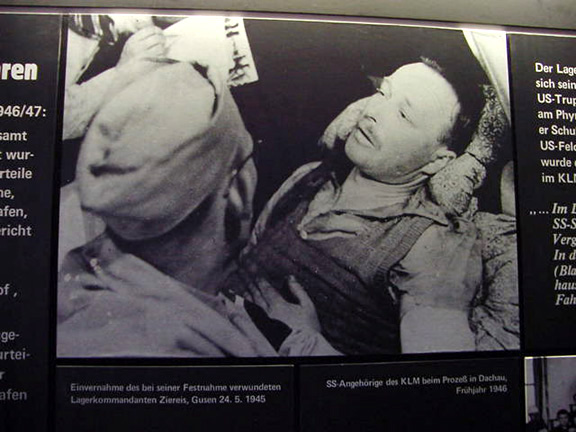Dachau TrialsUS. vs. Hans Altfuldisch, et alPrevious In a book which he wrote about the Mauthausen gas chamber, Pierre-Serge Choumoff, one of the former prisoners, quoted the testimony of the SS officers in Mauthausen, which he obtained from the trial testimony that was published in Rome in 1970. Choumoff included in his book the following trial testimony from Dr. Eduard Krebsbach, the chief doctor at Mauthausen until June 1943: It was on the order of Ziereis, the Kommandant of Mauthausen that Doctor Wasicky, the SS pharmacist, proceeded to organize the installation of a gas chamber. It was he who provided the necessary gas. The first gassing, which I attended in my capacity as doctor, took place early in 1942. From two hundred to three hundred prisoners were gassed. I particularly remember the gassing of about one hundred thirty Czechs who were implicated in the Heydrich affair. The "Heydrich affair" is a reference to the assassination of Reinhard Heydrich, the SS officer who was the governor of the German protectorate of Bohemia and Moravia after the country of Czechoslovakia was broken up by the Nazis in 1938. He was killed by Czech partisans who parachuted into what is now the Czech Republic, after being trained by the British in England. Note that Dr. Krebsbach names Dr. Erich Wasicky as the man who was in charge of the gas chamber at Mauthausen. Commandant Ziereis, in his deathbed confession, said that it was Dr. Krebsbach who was responsible for the gas chamber, although Dr. Wasicky provided the gas. The Mauthausen chamber used Zyklon-B pellets, according to a sign in the gas chamber today.  In the photograph above, the man on the far left is Hauptsturmführer Erich Wasicky, the camp apothecary or chemist. Third from the left is the Camp Commandant, Franz Ziereis; the man on his right is Sturmbannführer Eduard Krebsbach, the camp doctor until June 1943. Ziereis was nicknamed "Baby Face" by the prisoners. Note that all are wearing "jack boots," the symbol of "Nazi thugs." The testimony of SS Oberscharführer Josef Niedemayer, the Commandant of the bunker, which was the prison inside the camp, and also the officer in charge of the infamous Block 20, was included in Choumoff's book; his testimony at the trial is quoted as follows: There was a gas chamber in the camp. About four thousand prisoners were gassed there. When a transport arrived for the gas chamber, I informed the S.S. officers Bachmayer, Zutter or Altfuldisch. The men to be gassed were taken to the bunker where I, personally, with my assistants, S.S. officers Rommel and Proksch, verified the list of names and removed articles of value and documents. Then S.S. guards Roth and Gerber accompanied the condemned men to the gas chamber. After the execution, the S.S. dentists, Henkel and Franz Jutmann, removed the gold teeth. During March and April 1945, one thousand four hundred sick prisoners were gassed, selected by Doctor Wolter, the chief doctor (from August 1944). The photograph below, taken in May 2003, shows the gas chamber at Mauthausen. On the wall to the left is a memorial plaque for one of the prisoners who was allegedly gassed in this room. According to testimony by the prisoners at Mauthausen, the gassing operation continued right up to the end of April 1945, even while a Red Cross representative was in the camp, arranging the evacuation of some of the prisoners before the American liberators arrived. Note the peepholes. The doors were made of steel and could be unlatched from the inside. This room was also a fully functional shower room, as can be seen today.  The photograph below was taken in the Mauthausen museum. It shows Frank Ziereis, the Commandant of Mauthausen, as he lay dying of gunshot wounds on May 24, 1945. In the foreground is an American soldier; in the upper left hand corner, you can see the hand of a man who is taking notes, as Ziereis makes his death-bed confession about the gassing of prisoners in the shower room at Mauthausen. Ziereis also confessed that prisoners were gassed in vans that drove between the main Mauthausen camp and the sub-camps. Hans Marsalek was one of the Mauthausen prisoners who was there when Ziereis confessed that between one million and one and a half million prisoners had been gassed at Hartheim Castle, where there was a gas chamber that was 192 square feet in size. Marsalek wrote Ziereis's confession from memory in an affidavit ten months later; his affidavit was submitted at the Nuremberg IMT but Marsalek did not testify at Nuremberg.  Many of the SS men at Mauthausen escaped, were murdered, or committed suicide, so they were never brought to justice. According to Christian Bernadac, in his book "The 186 Steps," the Political Section of the camp administration "was responsible for all of the atrocities." It was directed by Obersturmführer Karl Schulz, who had been an assistant in the Criminal Police department of Cologne before joining the SS. According to Bernadac, Schultz escaped to Czechoslovakia during the night of May 2-3, 1945 (two days before the American liberators arrived) with his mistress, a stenotypist in the camp named Neugebauer, and a Czech prisoner named Krutis. His wife and son, who were living with him near the camp, remained behind. According to Bernadac, Josef Niedermayer was one of the four SS men assigned to the isolation bunker in the camp. He reported to Georg Bachmayer, one of the superior officers in the camp. Altfuldisch, Riegler, and Trumm also worked under Bachmayer in the detention section of the camp. Bernadac wrote that Bachmayer was a "sadist. His speciality consisted in exciting two mastiffs to leap on the prisoners and tear them to pieces." Bachmayer killed himself after first poisoning his wife and two daughters in May 1945 before he could be brought to justice by the Allies. Among the accused was Vincenz Nohel, an SS man who worked at the Hartheim Castle near Linz, Austria. Nohel said in his confession that 8,000 Mauthausen prisoners had been gassed at Hartheim Castle. However, Commandant Ziereis said in his confession that a total of 1 million to 1.5 million people had been gassed at Hartheim Castle. Dr. Entress, the chief doctor of Mauthausen from October 21, 1943 to July 26, 1944 confessed that he had selected prisoners to be gassed at Hartheim in the spring of 1944. The Lachout document, which is believed to be a forgery, claims that the confessions of the Mauthausen staff members were obtained by torture. Based on this controversial document, Holocaust deniers claim that there was no gas chamber at Mauthausen. The photograph below, taken in May 2003, shows the interior of the gas chamber at Hartheim Castle with a reconstruction of the pipe which was used to put carbon monoxide into the room for gassing people. On the left-hand side, at the top of the photo, is a window to the outside which has bars to prevent the victims from breaking the glass. The map on the wall shows the location of the gas chamber within the castle, which has an open courtyard in the center of the building.  Confessions of the AccusedProsecution WitnessesThe testimony of Willy FreyBack to the start of Mauthausen TrialThe Case against August EigruberThe Defense CaseJack Taylor TestimonyGas Chamber TestimonyTrial of Spanish KaposFranz Kofler TrialBack to Dachau TrialsBack to Mauthausen indexHomeThis page was last updated on March 28, 2012 |